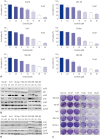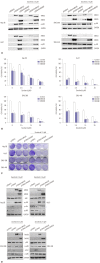Down-Regulation of TGF-β Expression Sensitizes the Resistance of Hepatocellular Carcinoma Cells to Sorafenib
- PMID: 28792132
- PMCID: PMC5552643
- DOI: 10.3349/ymj.2017.58.5.899
Down-Regulation of TGF-β Expression Sensitizes the Resistance of Hepatocellular Carcinoma Cells to Sorafenib
Abstract
Purpose: Sorafenib, a multikinase inhibitor, is the standard therapy for patients with advanced-stage hepatocellular carcinoma (HCC). However, resistance develops to the treatment, therefore, we tried to unravel the underlying mechanism in the resistance of HCC cells to sorafenib via the development of more effective therapeutic strategies.
Materials and methods: Various liver cancer cell lines were treated with either sorafenib only or with sorafenib after infection of adenovirus expressing short hairpin RNA (shRNA) against transforming growth factor-β (TGF-β) and p38 activity was examined using western blotting.
Results: p38 MAP kinase activity was inhibited by low concentrations of sorafenib, which could potentially lead to sorafenib resistance in HCC cell lines. Subsequently, we used constitutive form of MKK3/6 (MKK3/6E) to confirm that massive cell death was induced by the activation of p38, and demonstrated the ability to activate p38 without any stimulation. In addition, sorafenib resistance was reduced by the activation of p38. Subsequently, we confirmed that TGF-β shRNA effectively recovered the phosphorylation of p38 inhibited by sorafenib, and increased the sensitivity of HCC cells to sorafenib, thereby inducing cell death and overcoming the resistance of HCC cells to sorafenib.
Conclusion: Our study provides a new therapeutic strategy for HCC that overcomes the resistance of HCC to sorafenib by down-regulation of TGF-β.
Keywords: HCC; TGF-β; adenovirus; p38; resistance; sorafenib.
© Copyright: Yonsei University College of Medicine 2017
Conflict of interest statement
The authors have no financial conflicts of interest.
Figures





Similar articles
-
Hypoxia-mediated sorafenib resistance can be overcome by EF24 through Von Hippel-Lindau tumor suppressor-dependent HIF-1α inhibition in hepatocellular carcinoma.Hepatology. 2013 May;57(5):1847-57. doi: 10.1002/hep.26224. Epub 2013 Mar 14. Hepatology. 2013. PMID: 23299930
-
Upregulation of HIF-2α induced by sorafenib contributes to the resistance by activating the TGF-α/EGFR pathway in hepatocellular carcinoma cells.Cell Signal. 2014 May;26(5):1030-9. doi: 10.1016/j.cellsig.2014.01.026. Epub 2014 Jan 29. Cell Signal. 2014. PMID: 24486412
-
MK2206 overcomes the resistance of human liver cancer stem cells to sorafenib by inhibition of pAkt and upregulation of pERK.Tumour Biol. 2016 Jun;37(6):8047-55. doi: 10.1007/s13277-015-4707-1. Epub 2015 Dec 28. Tumour Biol. 2016. PMID: 26711788
-
Multiple Roles of Autophagy in the Sorafenib Resistance of Hepatocellular Carcinoma.Cell Physiol Biochem. 2017;44(2):716-727. doi: 10.1159/000485285. Epub 2017 Nov 23. Cell Physiol Biochem. 2017. PMID: 29169150 Review.
-
Deregulation of signaling pathways involved in sorafenib resistance of hepatocellular carcinoma.Klin Lab Diagn. 2013 Oct;(10):66-8, 34-7. Klin Lab Diagn. 2013. PMID: 24640100 Review. English, Russian.
Cited by
-
The Effect of Alpha Mangostin on Epithelial-Mesenchymal Transition on Human Hepatocellular Carcinoma HepG2 Cells Surviving Sorafenib via TGF-β/Smad Pathways.Adv Pharm Bull. 2020 Sep;10(4):648-655. doi: 10.34172/apb.2020.078. Epub 2020 Aug 9. Adv Pharm Bull. 2020. PMID: 33062605 Free PMC article.
-
Emerging Multifunctional Biomaterials for Addressing Drug Resistance in Cancer.Biology (Basel). 2025 May 2;14(5):497. doi: 10.3390/biology14050497. Biology (Basel). 2025. PMID: 40427686 Free PMC article. Review.
-
Phytochemical profiling and cytotoxic potential of Arnebia nobilis root extracts against hepatocellular carcinoma using in-vitro and in-silico approaches.Sci Rep. 2023 Jul 14;13(1):11376. doi: 10.1038/s41598-023-38517-8. Sci Rep. 2023. PMID: 37452082 Free PMC article.
-
The mechanisms of sorafenib resistance in hepatocellular carcinoma: theoretical basis and therapeutic aspects.Signal Transduct Target Ther. 2020 Jun 10;5(1):87. doi: 10.1038/s41392-020-0187-x. Signal Transduct Target Ther. 2020. PMID: 32532960 Free PMC article. Review.
-
Advancements in elucidating the mechanisms of Sorafenib resistance in hepatocellular carcinoma.Int J Surg. 2025 Apr 1;111(4):2990-3005. doi: 10.1097/JS9.0000000000002294. Int J Surg. 2025. PMID: 39992113 Free PMC article. Review.
References
-
- Llovet JM, Burroughs A, Bruix J. Hepatocellular carcinoma. Lancet. 2003;362:1907–1917. - PubMed
-
- Llovet JM, Ricci S, Mazzaferro V, Hilgard P, Gane E, Blanc JF, et al. Sorafenib in advanced hepatocellular carcinoma. N Engl J Med. 2008;359:378–390. - PubMed
-
- Bruix J, Sherman M Practice Guidelines Committee, American Association for the Study of Liver Diseases. Management of hepatocellular carcinoma. Hepatology. 2005;42:1208–1236. - PubMed
-
- Zhai B, Hu F, Jiang X, Xu J, Zhao D, Liu B, et al. Inhibition of Akt reverses the acquired resistance to sorafenib by switching protective autophagy to autophagic cell death in hepatocellular carcinoma. Mol Cancer Ther. 2014;13:1589–1598. - PubMed
MeSH terms
Substances
LinkOut - more resources
Full Text Sources
Other Literature Sources
Medical
Miscellaneous

